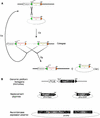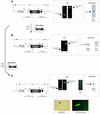Stable and efficient cassette exchange under non-selectable conditions by combined use of two site-specific recombinases
- PMID: 12409474
- PMCID: PMC135837
- DOI: 10.1093/nar/gnf114
Stable and efficient cassette exchange under non-selectable conditions by combined use of two site-specific recombinases
Abstract
Work of the last decade has proven the 'one gene- one product-one function' hypothesis an oversimplification. To further unravel the emerging 'one gene-multiple products-even more functions' concept, new methods (such as subtle knock-in and tightly regulated conditional mutations) for the analysis of gene function in health and disease are required. Another class of improvements (such as tetraploid fusion and cassette exchange) addresses the efficiency with which targeted mutant strains can be generated. Recombinase-mediated cassette exchange (RMCE), which in theory is well suited for the rapid generation of multiple alleles of a given locus, is hampered by its low efficiency in the absence of selection and, especially in vivo, by the promiscuity of the participating recombinase recognition sites. Here we present a novel approach which circumvents this problem by the use of two independent recombinase systems. The strategy, which uses loxP on one and FRT on the other side of the cassette together with a Cre/Flpe expression vector, prevents excisive events and results in higher rates of cassette integration without selection than previously described. This method has a huge potential for the generation of allelic series in embryonic stem cells and, importantly, in pre-implantation embryos in vivo.
Figures



References
-
- Bode J., Schlake,T., Iber,M., Schubeler,D., Seibler,J., Snezhkov,E. and Nikolaev,L. (2000) The transgeneticist’s toolbox: novel methods for the targeted modification of eukaryotic genomes. Biol. Chem., 381, 801–813. - PubMed
-
- Baer A. and Bode,J. (2001) Coping with kinetic and thermodynamic barriers: RMCE, an efficient strategy for the targeted integration of transgenes. Curr. Opin. Biotechnol., 12, 473–480. - PubMed
-
- Lauth M., Moerl,K., Barski,J.J. and Meyer,M. (2000) Characterization of Cre-mediated cassette exchange after plasmid microinjection in fertilized mouse oocytes. Genesis, 27, 153–158. - PubMed
-
- Seibler J., Schubeler,D., Fiering,S., Groudine,M. and Bode,J. (1998) DNA cassette exchange in ES cells mediated by Flp recombinase: an efficient strategy for repeated modification of tagged loci by marker-free constructs. Biochemistry, 37, 6229–6234. - PubMed
Publication types
MeSH terms
Substances
LinkOut - more resources
Full Text Sources
Other Literature Sources

